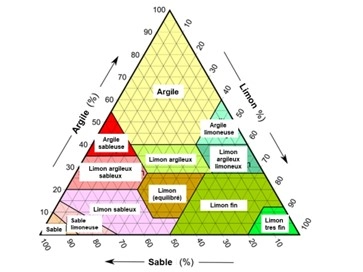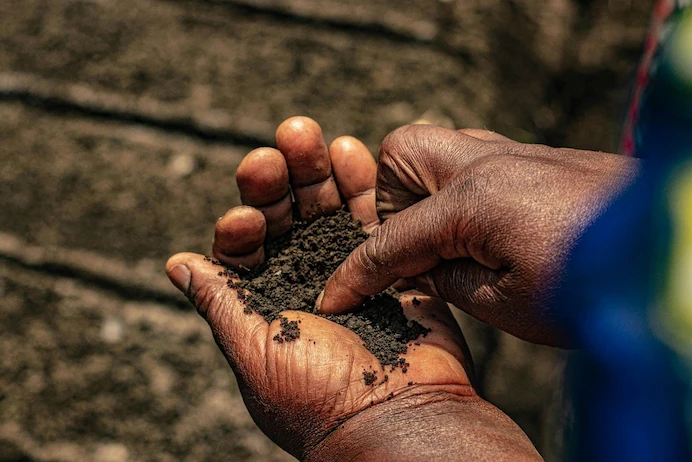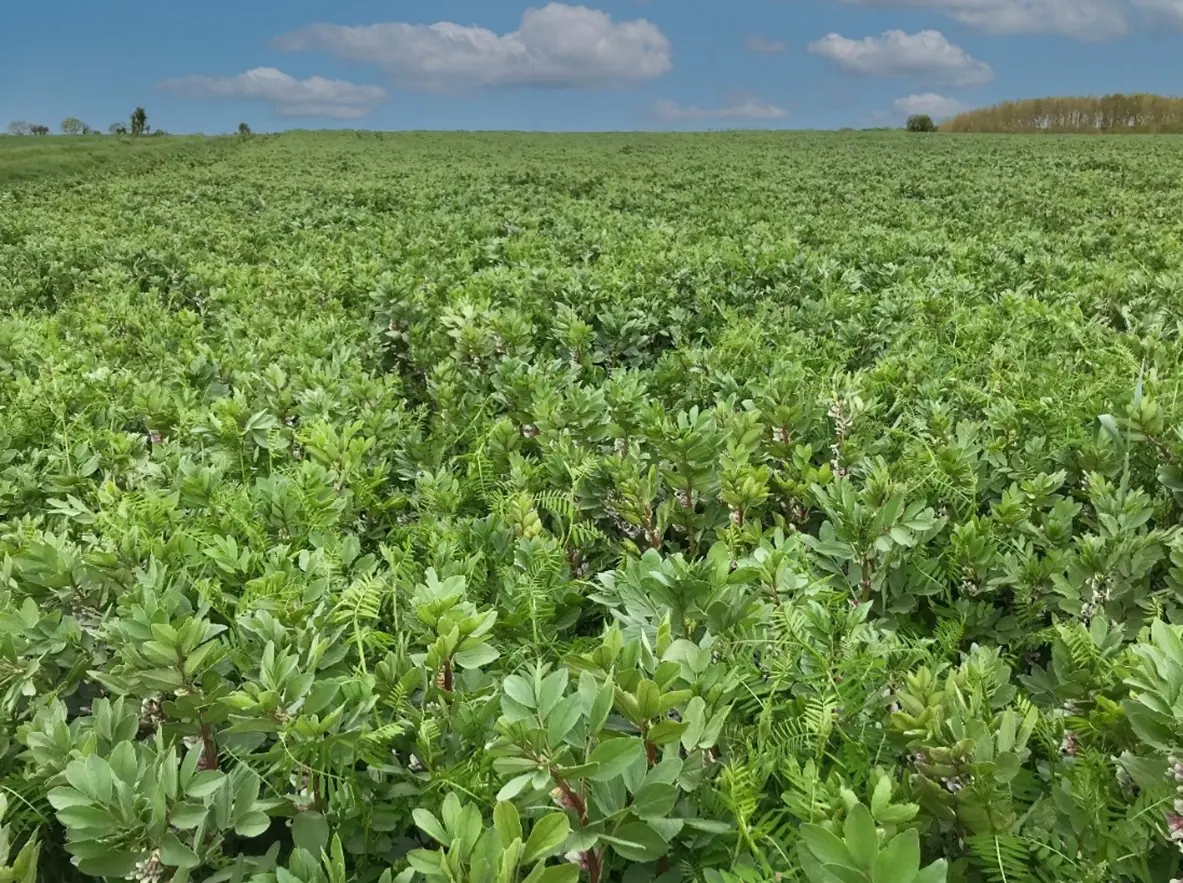How do you amend clay soil ?
A farm can be made up of several different types of soil. It’s important to know each plot so that you can adapt your work and your itineraries to get the best yield.
There are 4 main types of soil: sandy, silty, humus and clay. Clay soils are compact, dense, rich in nutrients (calcium, magnesium, potassium) but difficult to work. They do, however, have good water retention capacity and a number of advantages that make them ideal for certain crops.
Because clay is alkaline, it does not allow certain plants to capture all the available nutrients, which limits their growth and production. However, there are ways of improving the structure of these soils and revealing their richness, starting with soil amendment.

What does it mean to amend soil ?
The purpose of a soil improver is to improve the chemical, physical and biological properties of the soil. It is different from a fertiliser, which only provides fertilising elements for crops. There are two main types of soil improver:
–Organic soil improvers (manure, bark, compost, etc.). These are primarily intended to maintain the organic matter in the soil.
–Calcium-based soil improvers (agricultural lime, calcium carbonate, etc.), which improve soil structure and correct the balance between minerals.
Depending on the type of soil improver, it will be incorporated using a spreader, a tonne or tillage equipment…
Steps for amending clay soil
1 - Surface study
While it’s easy enough to determine whether a soil is clayey by hand, it’s advisable to carry out a physico-chemical analysis before any work is carried out.
By taking several soil samples from a plot of land and sending them to a laboratory, precise results can be obtained. This study will determine the level of acidity, texture, exact composition, cation exchange capacity and nutrients present. The most suitable soil improver(s) will then be selected.

A soil profile is also very useful for observing horizons. If there is a layer of pure clay, it is preferable to know the maximum depth at which it is possible to work without touching it, so as not to mix it with the other horizons.
Lastly, organic matter inputs will vary depending on the type of farm (mixed farming or livestock farming).
2 – When ?
As with any type of soil, it is strongly recommended that you work on dry ground. This is even truer for clays. If you want to work on them in wet conditions, you’ll need to increase your pulling power, because impregnated clay soil is heavy. Worse still, the passage of heavy machinery will lead to the creation of a sole of compaction and will smooth the soil. The exchanges essential to life will then be impossible.
THE ACTISOL ADVICE : It’s best to work the clays just before the winter period to “mature” the clumps of clay.
3 - Addition of organic matter
Favour organic soil improvers with carbon to nitrogen mass ratios of around 50 so that the organic particles are more easily assimilated into the clay humus complex.
THE 2 MAIN TYPES OF ORGANIC MATTER (OM) TO BE ADDED
The organic matter content shown in a soil analysis can be broken down into 2 forms: labile, free-form OM (20%) and bound OM of the slow type (80%). This balance is very important to respect. If the proportions differ too much from those shown above, the soil will not be viable for farming.
LABILE ORGANIC MATTER : Made up of rapidly degradable matter such as young green manure residues, manure, etc., it should be added in spring and late summer because it plays a vital role in feeding the soil’s fauna. They feed the primary decomposers and a large part of the microbial activity. Labile OM allows the soil to rapidly synthesise other nutrients to feed micro-organisms.
BONDED ORGANIC MATTER : This is made up of carbon compounds that break down after several stages of mineralisation, making mineral elements available. In other, more familiar terms, it acts as the soil’s ‘refrigerator’ It is made up mainly of crop residues with a high carbon-nitrogen ratio, which humify in the soil to provide raw material for the bacteria. These bacteria draw nutrients from the soil and make them available to plants. This OM plays a structural role in the soil.

The pH of a soil affects the role of organic matter. In acid soils, it slows the release of elements such as manganese. Conversely, in basic soils, it will ‘buffer’ with molybdenum (for example).
THE ACTISOL ADVICE : When you want to add calcium to correct an acid pH, make sure you never add a dose to correct more than 1 pH point. Adding too much calcium is not appropriate. It will block nutrients in the soil solution, making them unavailable to plants.
4 - Contribution of mineral matter
Before applying any nutrients, it is important to know what your soil needs and to adapt the nutrients accordingly :
- PRIMARY MINERALS:
NITROGEN (N): major elements responsible for the synthesis of chlorophyll.
PHOSPHORUS (P): the main constituent of plant cell walls. Its primary role is to control the uptake of nutrients and water by plants. This element is not very mobile in the soil.
POTASSIUM (K): very important for spring crops, it is responsible for the migration of elements within the plant.
- TRACE ELEMENTS:
Although they are present in the soil in smaller quantities than the primary NPK elements, they are nonetheless essential to the functioning of the soil. Absorption of each of these elements is directly dependent on the pH of the soil solution.
THE ACTISOL ADVICE : the optimum soil pH for all field crops and vegetables is between 6.8 and 7.2.
SULPHUR : the main constituent of amino acids. In sulphate form, combined with nitrates, it is rapidly assimilated.
MAGNESIUM : very important in protein synthesis, it combines with potassium (K2O) in spring crops. If it is present in too small quantities, potassium can be blocked and thus become unavailable for assimilation.
CALCIUM : central element of soil fertility. It plays a major role in the growth of plant cell walls (stem growth + flowering). In the soil, it is a fundamental structuring element and combines with clay to obtain a more ‘blown’ soil and fix ions in the clay-humus complex.
- MACRO-ELEMENTS:
Present in minute quantities in the soil, they will have a direct influence on certain crops with major needs.
BORON : regulates flowering and sugar migration in the plant. Beetroot is a crop that depends on this element.
MOLYBDENE : responsible for the creation of enzymes. Mainly vegetable crops (cabbage) but also crucifers (rape) are dependent on it.
5 - Plant cover as an amendment
Plant cover can act as a soil improver. This is called a green manure. It can absorb different elements depending on the type of cover planted (e.g. clover absorbs nitrogen from the air and returns it to the soil). The choice of species planted is therefore crucial, depending on the needs of the soil after study.
A green manure is planted in late summer or early autumn so that it can be destroyed before the next crop is sown in the spring. This will allow all the nutrients required by the next crop to be returned to the soil. The destruction window should be calculated accordingly.
In clay soils, rye, oats or mustard offer root development that loosens the soil on different horizons. The addition of one or more legumes, such as alfalfa or faba beans, will enrich the soil with nitrogen when they decompose.

6 - Controlling and maintaining clay soil
Regular monitoring of the state of the soil is essential if you are to retain the benefits you have already provided (soil profile, physico-chemical study, textural analysis, etc.). No two years are the same in terms of climatic hazards, so you need to keep a constant eye on and adapt the inputs and actions you put in place to keep your soil fertile and healthy.
What about crop rotation?
Growing the same crop on the same plot of land every year can cause a few problems. Find out more about crop rotation in our dedicated article.


